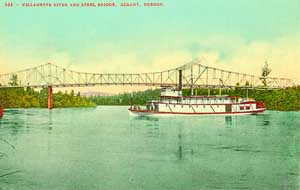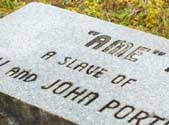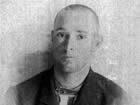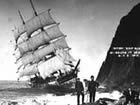Dory fisherman rescues stranded sailors — from Coast Guard boat
The conditions were too rough even for the legendary Coast Guard 36-foot motor lifeboat to make it through the breakers, so a fisherman brought them ashore two by two in his rowboat.

The lumber schooner Willapa, then named the Florence Olson, under
way a few years after its 1917 launching. The festive décor and the
large number of passengers suggest this image may have been
made at the ship’s launching. (Image: Superior Publishing) [Larger
image: 1600 x 857 px]
By Finn J.D. John — December 25, 2011
Downloadable audio file (MP3)
If you had to ride out a major storm at sea off the Oregon coast, what vessel would you choose? Here are your choices: A 1,185-ton steam schooner; a 36-foot U.S. Coast Guard motor lifeboat; or an 18-foot fishing dory.
Easy question, right?
Not for the 24 sailors and officers aboard the 1,185-ton steam schooner Willapa — whose lives were saved, two by two, by a fishing dory in skilled hands one stormy morning in 1941 off Port Orford.
Here’s what happened:
In 1941, the Willapa was one of the last of a dying breed — the wooden steam schooners that had been the mainstay of West Coast lumber shipping since about 1890. These were small, maneuverable steamships, ranging from 90 to 200 feet or so in length. They had to be tiny, to fit into the “doghole” ports they worked out of, but that left them unusually vulnerable when nasty weather came along. Of the several hundred of these that were built, a strikingly high percentage ended up on rocks or beach, or simply pounded apart by enormous seas while wallowing along with tons of lumber piled on their decks.
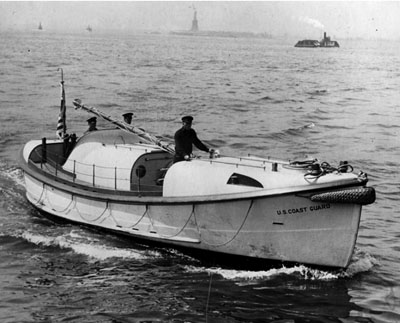
A 36-foot U.S. Coast Guard Type T motor lifeboat under way in
New York Harbor. Type T motor lifeboats were built in the late
1920s and into the 1930s, and the rescue boat that came to retrieve
the Willapa’s crew was most likely of this type. It is easy to
imagine the difficulties involved with loading 24 people onto a boat
like this. (Image: U.S. Coast Guard) [Larger image: 1200 x 969 px]
And that’s exactly what happened to the Willapa on the black, stormy night of Dec. 1, 1941 (actually, it was probably the very-early morning of Dec. 2).
The Willapa was getting to be an old vessel, which may have contributed to her breakup; she was built at Kruse and Banks in North Bend during World War I. Now, on the eve of World War II, her career was over. The persistent pounding of the waves finally started opening up seams, and water started pouring in.
Captain Oscar Peterson ordered distress flares fired off. The dying ship lit up the skies with rockets, one after another, until the lot of them was gone and the ship left in inky, stormy blackness.
Luckily, the Coast Guard lookout saw the show and scrambled the rescue crews into one of the service’s new 36-foot motor lifeboats. Out to sea they went to see what they could do. But by this time, the Willapa was out of flares, and the lifeboat crew could find nothing on the mountainous seas. Surely at some point the rescuers must have given the ship up for lost, but they kept searching until morning came.
A fisherman named Don readies his dory, the Osprey, for a day’s
fishing at Pacific City. This modern plywood dory sports an outboard
motor; the dory used to rescue the Willapa’s crew would have been
powered by oars and probably was a lapstrake boat, but shared the
general dimensions and lines: a towering bow to tame the breakers
and a deep-cut transom to shunt away a following sea.
(Image: home.comcast.net/~dorypage)
In the light of dawn, the lifeboat crew found the stricken Willapa — and got there just in time. Now well and truly dead, the Willapa was fully awash, boilers out, getting ready to roll over. Being made of wood, she wasn’t going to sink — but she wouldn’t be of any use at all for life preservation floating upside down in thirty-foot seas and covered with barnacles. Moreover, in the 50-degree waters off the Oregon coast, it’s the cold that does the real killing. The men had to be taken off that ship, immediately.
So into (and onto!) the 36-footer piled all 24 crew members. By the time the last one was rescued, the ship was on its side, almost all the way under. Theoretically, the thing to do would have been to take 12 men at a time. But had they done that, the other 12 would not have been alive when the lifeboat returned for them.
So, crammed with men like a can of sardines, the motor lifeboat worked its way back toward the shore. In the giant offshore swells, it was still good and seaworthy, though heavy laden. But the lifesaving crew knew when they got to the breakers near the shore, there would be trouble.

The Willapa under way with no deck load, probably sometime in the
1920s. (Image: Superior Publishing) [Larger image: 1800 x 984 px]
(There may have been other problems with the boat as well to account for this, although the sources don't say so. On paper, a 36-foot motor lifeboat should have been more than capable of taking 24 men to shore. But for whatever reason, on this particular day, this particular "MLB" was not.)
Enter the fisherman. His name was James Combs; he had a fishing dory, the type famously used by the fishermen at Cape Kiwanda, and he knew how to use it — according to James Gibbs, he “handled it like a row boat in a mill pond.” Out through the surf he went, rowing the 800 yards past the breakers to the wallowing lifeboat just beyond. There he took on two passengers, and rowed back. Then he did it again.
And again. And again.
Eventually, Combs had enough of the surplus crew members off the motor lifeboat that the rescue vessel could safely bring the rest in to shore. And yes, every single one of them survived. There were no casualties in this wreck.

This photo links to the U.S. Coast Guard's informational Website
detailing all Coast Guard small craft used throughout the agency's
history.
As for the Willapa, it broke up in just a few hours, and a couple days later started washing up on shore as driftwood.
So, what’s your call? The steam schooner, the motor lifeboat or the dory?
Of course, if the steam schooner hadn’t been old and tender, it would probably have been just fine. And if the motor lifeboat hadn’t been packed with so many castaways it was barely seaworthy, it would have been a fine choice — for most of us, the best choice.
But if it came with an experienced Oregon Coast dory fisherman like James Combs at the oars, you might just be better off in a little open fishing boat.
(Sources: Gibbs, James. Shipwrecks of the Pacific Coast. Portland: Binford, 1957; Newell, Gordon & al. Pacific Lumber Ships. Seattle: Superior, 1960; Marshall, Don. Oregon Shipwrecks. Portland: Binford, 1984)
TAGS: #Topic153 #PortOrford #USCG #MotorLifeboat #36foot #Willapa #SteamSchooner #Doghole #KruseAndBanks #NorthBend #OscarPeterson #JamesCombs #DoryFisherman #1940s #COAST #CURRYcounty









